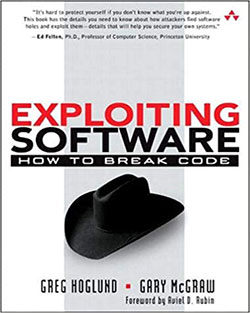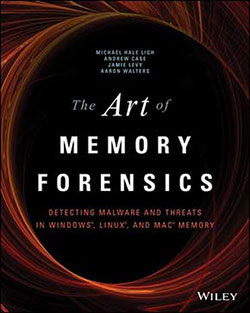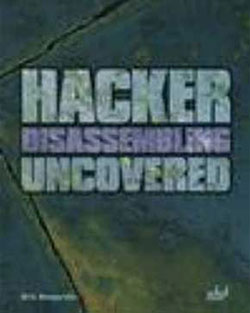Reverse engineering is the art of extracting information from a given man-made device or software, it’s taking apart an object to see how it works in order to duplicate or enhance the object. here we will list the Best Reverse Engineering Books for that art.
You can reverse engineer anything that can be broken apart, and then put back together.
Reverse engineering is now frequently used on computer hardware and software.

A famous example of reverse-engineering involves San Jose-based Phoenix Technologies Ltd., which in the mid-1980s wanted to produce a BIOS for PCs that would be compatible with the IBM PC’s proprietary BIOS. (A BIOS is a program stored in firmware that’s run when a PC starts up; see Technology QuickStudy, June 25.)
| IMAGE | NAME | INFO | Price |
|---|---|---|---|
 | Exploiting Software: How to Break Code | Exploiting Software highlights the most critical part of the software quality problem. | Check Price |
 | Reversing: Secrets of reverse engineering | Helps developers plug security holes by demonstrating how hackers exploit reverse engineering techniques | Check Price |
 | The Ghidra Book: The Definitive Guide | A guide to using the Ghidra software reverse engineering tool suite. | Check Price |
 | The IDA Pro Book | The IDA Pro book: the unofficial guide to the world's most popular disassembler | Check Price |
 | Practical Reverse Engineering | Practical Reverse Engineering: x86, x64, ARM, Windows Kernel, Reversing Tools, and Obfuscation | Check Price |
 | The Art of Memory Forensics | Detecting Malware and Threats in Windows, Linux, and Mac Memory | Check Price |
 | Practical malware analysis | Practical Malware Analysis: The Hands-On Guide to Dissecting Malicious Software | Check Price |
 | hacker disassembling uncovered | Powerful Techniques To Safeguard Your Programming | Check Price |
 | The rootkit arsenal | Escape and Evasion in the Dark Corners of the System 2nd Edition | Check Price |
To protect against charges of having simply (and illegally) copied IBM’s BIOS, Phoenix reverse-engineered it using what’s called a “clean room,” or “Chinese wall,” approach. First, a team of engineers studied the IBM BIOS—about 8KB of code—and described everything it did as completely as possible without using or referencing any actual code. Then Phoenix brought in a second team of programmers who had no prior knowledge of the IBM BIOS and had never seen its code. Working only from the first team’s functional specifications, the second team wrote a new BIOS that operated as specified.
if you are looking for Hacking Books Check this list of Best Hacking Books
What is reverse engineering?
In the Internet era, there are many reasons for reverse engineering in various fields. Reverse engineering originates from hardware analysis of commercial or military advantages. However, the reverse engineering process itself does not involve creating copies or changing artifacts in some way; it is just an analysis to infer design features from the product, with little or no other knowledge of the procedures involved in its original production. In some cases, the goal of the reverse engineering process can simply be a legacy system of document reconstruction. Even if reverse engineered products are competitors ’products, the goal may not be to copy them but to conduct competitor analysis.

Reverse engineering can also be used to create interoperable products. Despite some narrow US and EU legislation, the legality of using specific reverse engineering techniques for this purpose has been debated in courts around the world for over 20 years. Software reverse engineering can help improve the understanding of the underlying source code in order to maintain and improve the software, can extract relevant information to make software development decisions, and the graphical representation of the code can provide an alternate view of the source code, which can help detect and repair Software errors or vulnerabilities.
Generally, with the development of certain software, its design information and improvements are usually lost over time, but such lost information can usually be recovered through reverse engineering. This process also helps reduce the time required to understand the source code, thereby reducing the overall cost of software development.
Reverse engineering can also help detect and eliminate malicious code written into software using better code detectors. Reversing the source code can be used to find alternative uses of the source code, such as detecting unauthorized copying of unused source code, or revealing how competitor products are built. This process is often used to “crack” software and media to remove its copy protection, or to create (possibly improved) copies or even counterfeit goods, which are usually targets or hackers of competitors. Malware developers often use reverse engineering techniques to find vulnerabilities in the operating system (OS) in order to build computer viruses that can exploit system vulnerabilities. Reverse engineering is also used in password analysis to replace passwords, symmetric key algorithms or public Vulnerabilities found in key encryption.
Best reverse engineering books
There is a lot of Reverse Engineering Books but the question is where to start and what is the best Reverse Engineering Books to read and learn from ? here is a list of our best books
The Best

Exploiting Software highlights the most critical part of the software quality problem.
Exploiting Software: How to Break Code
How does software break? How do attackers make software break on purpose? Why are firewalls, intrusion detection systems, and antivirus software not keeping out the bad guys? What tools can be used to break software? This book provides the answers.
This book is studded with examples of real attacks, attack patterns, tools, and techniques used by bad guys to break software.
If you want to protect your software from attack, you must first learn how real attacks are really carried out.
Learn about:
- Why software exploit will continue to be a serious problem;
- When network security mechanisms do not work;
- Attack patterns;
- Reverse engineering;
- Classic attacks against server software;
- Surprising attacks against client software;
- Techniques for crafting malicious input;
- The technical details of buffer overflows; and Rootkits.
This information needs to be understood and digested by security professionals so that they know the magnitude of the problem and they can begin to address it properly. Today, all developers should be security-minded. The knowledge here will arm you with a real understanding of the software security problem.
Our Pick

Reversing: Secrets of reverse engineering
One of the best Reverse Engineering Books is Reversing: Secrets of reverse engineering the book Begin with a basic primer on reverse engineering-including computer internals, operating systems, and assembly language-and then discussing the various
applications of reverse engineering, this book provides readers with practical, in-depth techniques for software reverse engineering.
Secrets of reverse engineering book is broken into two parts, the first deals with security-related reverse engineering and the second explores the more practical aspects of reverse engineering.
The first popular book to show how software reverse engineering can help defend against security threats, speed up development, and unlock the secrets of competitive products
Helps developers plug security holes by demonstrating how hackers exploit reverse engineering techniques to crack copy-protection schemes and identify software targets for viruses and other malware
Offers a primer on advanced reverse-engineering, delving into “disassembly”-code-level reverse engineering-and explaining how to decipher assembly language.
Our Pick

A guide to using the Ghidra software reverse engineering tool suite.
The Ghidra Book: The Definitive Guide
The result of more than a decade of research and development within the NSA, the Ghidra platform was developed to address some of the agency’s most challenging reverse-engineering problems. With the open-source release of this formerly restricted tool suite, one of the world’s most capable disassemblers and intuitive decompilers is now in the hands of cybersecurity defenders everywhere — and The Ghidra Book is the one and only guide you need to master it.
The Ghidra Book In addition to discussing RE techniques useful in analyzing software and malware of all kinds, the book thoroughly introduces Ghidra’s components, features, and unique capacity for group collaboration. You’ll learn how to:
- Navigate a disassembly
- Use Ghidra’s built-in decompiler to expedite analysis
- Analyze obfuscated binaries
- Extend Ghidra to recognize new data types
- Build new Ghidra analyzers and loaders
- Add support for new processors and instruction sets
- Script Ghidra tasks to automate workflows
- Set up and use a collaborative reverse engineering environment
Our Pick

The IDA Pro book: the unofficial guide to the world’s most popular disassembler
The IDA Pro Book
The best software Reverse Engineering Book is The IDA Pro, No source code? No problem. With IDA Pro, the interactive disassembler, you live in a source code-optional world. IDA can automatically analyze the millions of opcodes that make up an executable and present you with a disassembly. But at that point, your work is just beginning. With The IDA Pro Book, you’ll learn how to turn that mountain of mnemonics into something you can actually use.
Hailed by the creator of IDA Pro as “profound, comprehensive, and accurate,” the second edition of The IDA Pro Book covers everything from the very first steps to advanced automation techniques. You’ll find complete coverage of IDA’s new Qt-based user interface, as well as increased coverage of the IDA debugger, the Bochs debugger, and IDA scripting (especially using IDAPython). But because humans are still smarter than computers, you’ll even learn how to use IDA’s latest interactive and scriptable interfaces to your advantage.
Save time and effort as you learn to:
- Navigate, comment, and modify disassembly
- Identify known library routines, so you can focus your analysis on other areas of the code
- Use code graphing to quickly make sense of cross references and function calls
- Extend IDA to support new processors and filetypes using the SDK
- Explore popular plug-ins that make writing IDA scripts easier, allow collaborative reverse engineering, and much more
- Use IDA’s built-in debugger to tackle hostile and obfuscated code
Whether you’re analyzing malware, conducting vulnerability research, or reverse engineering software, a mastery of IDA is crucial to your success. Take your skills to the next level with this 2nd edition of The IDA Pro Book.
Our Pick

Practical Reverse Engineering: x86, x64, ARM, Windows Kernel, Reversing Tools, and Obfuscation
Practical Reverse Engineering
Analyzing how hacks are done, so as to stop them in the future
Reverse engineering is the process of analyzing hardware or software and understanding it, without having access to the source code or design documents. Hackers are able to reverse engineer systems and exploit what they find with scary results.
Now the good guys can use the same tools to thwart these threats. Practical Reverse Engineering goes under the hood of reverse engineering for security analysts, security engineers, and system programmers, so they can learn how to use these same processes to stop hackers in their tracks.
The book covers x86, x64, and ARM (the first book to cover all three); Windows kernel-mode code rootkits and drivers; virtual machine protection techniques; and much more. Best of all, it offers a systematic approach to the material, with plenty of hands-on exercises and real-world examples.
- Offers a systematic approach to understanding reverse engineering, with hands-on exercises and real-world examples
- Covers x86, x64, and advanced RISC machine (ARM) architectures as well as deobfuscation and virtual machine protection techniques
- Provides special coverage of Windows kernel-mode code (rootkits/drivers), a topic not often covered elsewhere, and explains how to analyze drivers step by step
- Demystifies topics that have a steep learning curve
- Includes a bonus chapter on reverse engineering tools
Practical Reverse Engineering: Using x86, x64, ARM, Windows Kernel, and Reversing Tools provides crucial, up-to-date guidance for a broad range of IT professionals.
Our Pick

Detecting Malware and Threats in Windows, Linux, and Mac Memory
The Art of Memory Forensics
Memory forensics provides cutting edge technology to help investigate digital attacks
Memory forensics is the art of analyzing computer memory (RAM) to solve digital crimes. As a follow-up to the best seller Malware Analyst’s Cookbook, experts in the fields of malware, security, and digital forensics bring you a step-by-step guide to memory forensics—now the most sought after skill in the digital forensics and incident response fields.
Beginning with introductory concepts and moving toward the advanced, The Art of Memory Forensics: Detecting Malware and Threats in Windows, Linux, and Mac Memory is based on a five day training course that the authors have presented to hundreds of students. It is the only book on the market that focuses exclusively on memory forensics and how to deploy such techniques properly. Discover memory forensics techniques:
- How volatile memory analysis improves digital investigations
- Proper investigative steps for detecting stealth malware and advanced threats
- How to use free, open source tools for conducting thorough memory forensics
- Ways to acquire memory from suspect systems in a forensically sound manner
The next era of malware and security breaches are more sophisticated and targeted, and the volatile memory of a computer is often overlooked or destroyed as part of the incident response process. The Art of Memory Forensics explains the latest technological innovations in digital forensics to help bridge this gap. It covers the most popular and recently released versions of Windows, Linux, and Mac, including both the 32 and 64-bit editions.
Our Pick

Practical Malware Analysis: The Hands-On Guide to Dissecting Malicious Software
Practical malware analysis
Malware analysis is big business, and attacks can cost a company dearly. When malware breaches your defenses, you need to act quickly to cure current infections and prevent future ones from occurring. For those who want to stay ahead of the latest malware, Practical Malware Analysis will teach you the tools and techniques used by professional analysts.
With this book as your guide, you’ll be able to safely analyze, debug, and disassemble any malicious software that comes your way.
with this Reverse Engineering Book You’ll learn how to:
- Set up a safe virtual environment to analyze malware
- Quickly extract network signatures and host-based indicators
- Use key analysis tools like IDA Pro, OllyDbg, and WinDbg
- Overcome malware tricks like obfuscation, anti-disassembly, anti-debugging, and anti-virtual machine techniques
- Use your newfound knowledge of Windows internals for malware analysis
- Develop a methodology for unpacking malware and get practical experience with five of the most popular packers
- Analyze special cases of malware with shellcode, C ++, and 64-bit code
Initially, it is worth mentioning that specialized books on malware analysis, reversing, debugging, etc. very rare. And even more so, books that explain in sufficient detail and from the basics all stages of the study. Of course, in addition to Practical Malware Analysis, there are other equally worthy publications on this topic. However, it is Practical Malware Analysis that combines a kind of training manual, which describes in detail the working tools and the used reversing techniques, as well as a list of laboratory works for the material described above at the end of the chapter. With each new chapter, the reader will learn more material, as well as perform increasingly complex homework.
Our Pick

Powerful Techniques To Safeguard Your Programming
hacker disassembling uncovered
You’ll be learning all about assembly structure, how are programs laid and built out, how to work together with libraries to achieve two-sided results, tips and research on relocation, loaders, and dozens of others topics that will stretch into quite the learning experience.
There are many reviews from system administrator, kernel operators and other technical workers who say this book is a must for anyone looking to gain experience with reverse engineering
Hacker Disassembling Uncovered shows how to analyze programs without its source code, using a debugger and a disassembler. Covers hacking methods including virtual functions, local and global variables, branching, loops, objects and their hierarchy, and mathematical operators. For intermediate to advanced level programmers.
Kris Kaspersky is the author of articles on hacking, disassembling, and code optimization. He has dealt with issues relating to security and system programming including compiler development, optimization techniques, security mechanism research, real-time OS kernel creation, and writing antivirus programs.
Our Pick

Escape and Evasion in the Dark Corners of the System 2nd Edition
The rootkit arsenal
The rootkit arsenal is one of the best Reverse Engineering Books, While forensic analysis has proven to be a valuable investigative tool in the field of computer security, utilizing anti-forensic technology makes it possible to maintain a covert operational foothold for extended periods, even in a high-security environment.
Adopting an approach that favors full disclosure, the updated Second Edition of The Rootkit Arsenal presents the most accessible, timely, and complete coverage of forensic countermeasures. This book covers more topics, in greater depth, than any other currently available. In doing so the author forges through the murky back alleys of the Internet, shedding light on material that has traditionally been poorly documented, partially documented, or intentionally undocumented.
The range of topics presented includes how to: -Evade post-mortem analysis -Frustrate attempts to reverse engineer your command & control modules -Defeat live incident response -Undermine the process of memory analysis -Modify subsystem internals to feed misinformation to the outside -Entrench your code in fortified regions of execution -Design and implement covert channels -Unearth new avenues of attack
Reverse Engineering Books will teach you step by step but won’t make you smart!
what I mean is you must find your own ways and never relay on Reverse Engineering Books only. Tow men can read the same book but won’t get the same result.
Reversing is like art
Today, malware analysis is a whole industry in the field of information security. Antivirus laboratories that release their products for protection, and highly specialized groups of experts striving to be in the trend of attack vectors, and even virus writers themselves, who compete with each other for a potential client, are engaged in it. For a virus analyst sitting in the dungeons of a major developer, this is a day-to-day painstaking work that sometimes requires a non-standard and proactive approach. However, despite the fact that the functionality of malware is constantly being improved and obfuscation techniques are being modified, the general methods of analysis have remained unchanged for a long time.
One of the important parts of malware analysis is reverse engineering, or “reverse engineering,” of software. In a nutshell, reversing is an attempt to study and recreate the algorithms of the program without having the source codes on hand, using special debugging techniques. Compared to malware analysis, there are a lot of very subtle nuances here. First, software reversing in the vast majority of cases is prohibited by a license agreement, so any attempts to learn something for "educational purposes" are made only at your own peril and risk. Malware analysis does not contain such restrictions, moreover, this is a "noble cause" - for example, having studied how ramsomware encrypts the victim's files, you can try to create a decryptor for it, which, by the way, is very often done by anti-virus software developers. Secondly, reversing, as a rule, is directed towards commercial software, which makes a trial or unregistered version of software quite working (warez). In other words, it is the distribution of pirated copies of software. These actions violate many articles of copyright and intellectual law, patent law, international agreements and the like.
Despite the disapproval of the majority of government officials, IT business and the law, in the hacker sense, reversing has positive aspects. For example, through the study of software, many security experts have discovered various undocumented features in software, which have turned into a big scandal for vendors and manufacturers. This also includes the found 0day vulnerabilities, which were not advertised to the public before the release of the official patches. Fans of open source most likely know the term Clean room design, in other words, a way to copy a design without violating the developer's copyright and trade secrets. This, for example, is done with proprietary Nvidia graphics drivers for Linux systems, trying to recreate the original architecture in order to release an open source driver.
Best malware analysis books
Best Hacking Books
Best Kali Linux books

Hi, I am interested in learning more about what you do. Is there a best way to contact you?
Thanks for this valuable information about the books of reverse engineering.